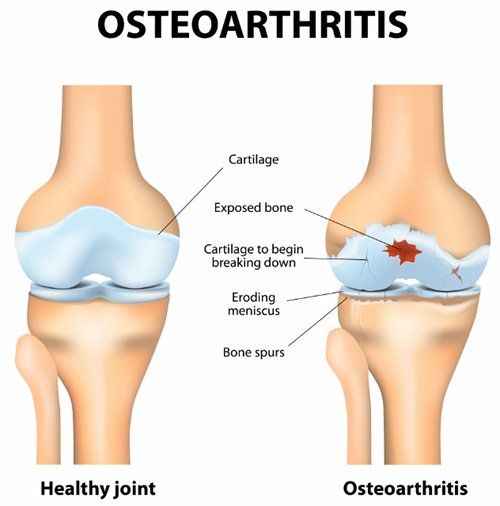Key points
Osteoarthritis is a breakdown of the cartilage inside a joint
Osteoarthritis is one of the most common forms of arthritis. It’s most likely to develop in people over the age of 45, but it can occur in younger people. Many people will develop symptoms as they age.

Your joints
Joints are places where your bones meet. Bones, muscles, ligaments and tendons all work together so that you can bend, twist, stretch and move about.
The ends of your bones are covered in a thin layer of cartilage. It acts like a slippery cushion absorbing shock and helping your joint move smoothly.
The joint is wrapped inside a tough capsule filled with synovial fluid. This fluid lubricates and nourishes the cartilage and other structures in the joint.
With OA, cartilage becomes brittle and breaks down. Some pieces of cartilage may even break away and float around inside the synovial fluid. Because the cartilage no longer has a smooth, even surface, the joint becomes stiff and painful to move.
Eventually the cartilage can break down so much that it no longer cushions the two bones. Your body tries to repair this damage by creating extra bone. These are bone spurs.
Bone spurs don’t always cause symptoms, but they can sometimes cause pain and restrict joint movement.
Symptoms
The symptoms of OA varies from person to person.
Some of the more common symptoms include:
-
joint stiffness
-
joint swelling (inflammation)
-
grinding, rubbing or crunching sensation (crepitus)
-
joint pain
-
muscle weakness.
Joints affected by osteoarthritis
Most commonly it’s the weight-bearing joints that are affected by OA, but all joints can develop OA including:
-
knees
-
hips
-
spine
-
hands.
Causes
There are many things that can increase your chances of developing OA including:
-
your age - people over 45 are more at risk
-
being overweight or obese
-
family history of OA
-
significant injury, damage or overuse of a joint.
Diagnosis
If you’re experiencing joint pain, it’s important that you discuss your symptoms with your doctor. Getting a diagnosis as soon as possible means that treatment can start quickly. Early treatment will give you the best possible outcomes.
To diagnose your condition your doctor will:
-
take your medical history – this will include finding out about your symptoms, how long you’ve had them, what makes them better or worse
-
examine the affected joint/s.
Your doctor may also order an x-ray or MRI to get a clearer picture of what’s happening inside your joints.
Treatment
There’s no cure for OA, but it can be managed effectively using exercise, weight loss, medications, and in some cases surgery.
Exercise
Regular exercise can help reduce some of the symptoms (e.g. pain, stiffness) caused by your condition and improve your joint mobility and strength.
Cartilage doesn’t have a blood supply, so it relies on the synovial fluid moving in and out of your joints for nourishment and to remove any waste.
Exercises that involve moving your joints through their range of movement will also help maintain the flexibility that’s often lost as a result of OA.
Strengthening the muscles around your joints is also important. The stronger they are, the more weight they can take. This will help support and protect your joints.
Exercise has many other health benefits. It can:
-
ease pain and stiffness in your joints and muscles
-
improve your balance and posture
-
help you sleep better
-
improve your mood
-
help you maintain a healthy weight, or lose weight when combined with a weight loss diet
-
lower stress levels
-
reduce your risk of developing other chronic health issues (e.g. diabetes, heart disease).
Talk to your doctor, physiotherapist or exercise physiologist about suitable exercises for you. An exercise program that promotes muscle strength, joint flexibility, improved balance and coordination, as well as general fitness will give you the best results.
Other ways to manage arthritis
Other techniques that can help in the management of osteoarthritis include:
Education – find out about your condition. Click here to find out about seminars, webinars and other events to help you learn more about your condition.
Weight management – controlling weight is important for those who are overweight and have osteoarthritis in weight-bearing joints. Your doctor or dietitian may be able to advise you on safe weight loss strategies.
Medication – pain-relieving medications can help, as advised by your doctor.
Relaxation techniques – for example, muscle relaxation, meditation or visualisation – can help manage pain and the difficult emotions, such as anxiety, which are sometimes experienced by people with arthritis.
Support – seek support from others, including family, friends, work colleagues and health professionals. A support or self-help group may be another option.
Surgery – damaged joints can be replaced in cases of advanced osteoarthritis.
Patella taping, knee braces and orthotics – may be useful in the management of knee osteoarthritis. Seek advice from a physiotherapist or podiatrist.
Equipment that promotes independence – many specially designed aids and types of equipment are available to help people with painful joints. The design of this equipment, such as large-handled kitchen utensils, reduces the strain on the joints. For more information, speak to an occupational therapist.
Where to get help
-
Your doctor
MOVE muscle, bone & joint health
National Help Line: 1800 263 265
Things to remember
-
Osteoarthritis occurs when the cartilage inside a joint breaks down causing pain and stiffness
-
People over 45 are more at risk, but younger people can be affected too
-
Exercise is one of the best ways to manage osteoarthritis
More to explore
The whole or part of this material is copyright to the State of Victoria and the Better Health Channel. Reproduced with permission of the Victorian Minister for Health. Users are permitted to print copies for research, study or educational purposes.




